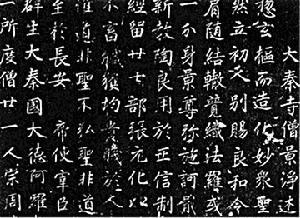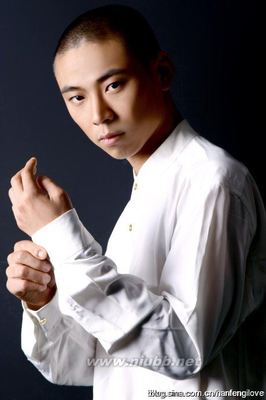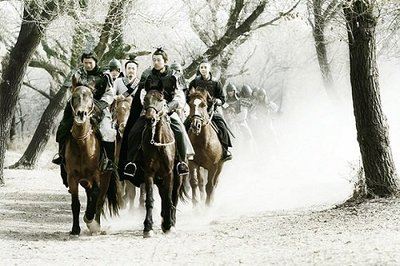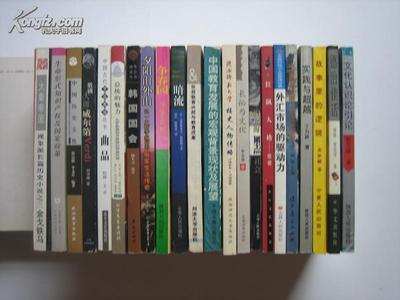“把这篇文字设法译出来并不难,实际上也有人译过,可是要译得正确和准确是极为困难的,因为这篇碑文是如此古雅、崇高而深邃,在中国也是无与伦比的。”
——《中国来信》捷克耶稣会士严嘉乐神父1734年7月23日
《大秦景教流行中国碑》碑文记载了基督教最早传入中国的情况。因为好奇,想知道景教(聂斯托里派的基督教——当时被判为异端)到底与我们现在所知道的基督教有什么区别?所以想看看碑文里到底说了些什么。
景教碑文现代中文翻译真是一纸难求。无奈,参照英译文,结合古文,我自己蒙了一篇现代中文译文。贴在这里,请别见笑,比没有好呀。有谁知道现成的,敬请推荐。
翻译过程中充满惊喜。
原来,唐太宗李世明是中国历史上最早的“慕道友”。公元635年,当大秦国主教阿罗本来唐时,太宗皇帝派遣宰相房公玄龄,带领臣仆们到西郊欢迎,迎宾入宫,并邀至皇帝藏书室,翻译经典,皇帝在禁宫内亲自问道。皇帝深感此道之正义和真实,下令传授于民。太宗下诏说:“详其教旨,玄妙自然,观其元宗,源于真理。言辞清晰,道理隽永。济物利人,宜行天下。”这位太宗皇帝够慕道的了吧!
另外一处也使我惊喜:这一句——“宗周德丧,青驾西升。巨唐道光,景风东扇。”原来是说:周朝衰败,老子去了西方,唐朝兴起,基督教来到东方。当年老子(公元前6世纪)留下五千字《道德经》,在函谷关,骑青牛西去,不知去向。莫非是去了大秦国(叙利亚)?逼老子留字的关令伊喜,看到“紫气东来”,便知道是圣人来了。李世民等了一千多年,可真等到“景气东来”。这一回,三一真神的使者终于亲自来到老子的故乡。
还好,唐朝开明,太宗识货,知道真道之宝贵。听听:惟道非圣不弘,圣非道不大。至理名言啊!
现代中文译文
奇妙真道,亘古不变,真实无声,在万有之先,无始无终,眼所不能见,自在永在。创造宇宙万物,至高至圣,三位一体,奇妙永恒的独一真神。判十字以定四极,赐圣灵以生二气;开天劈地,地不再空虚混钝;日月运行,昼夜肇始;万物匠成,始造人类先祖;赐予上帝本来良善和熙之形象,令人管理天地万物;性情宽厚谦卑,单纯朴素。撒旦魔鬼的诱惑,败坏了原初完美纯洁的本性;恶性渐长,善性渐微,自结365种罗网,纷然沓至;误以偶像为源头,或将原初旨意化为乌有,或藉祈祷祭拜以求福祉,或假冒为善自傲于人。营营役役,思虑愁烦,茫然无得,徒劳无功;久久迷途在愚昧之中,找寻不到原初路径。
因此,三一真神派遣光明荣耀的圣子救主弥撒亚,降卑为人,来到人间。神差遣天使报佳音,宣告童女玛丽亚怀孕生子于大秦(叙利亚)。明星告祥,波斯博士见星象带着礼物来朝拜圣子。二十四位圣者所著齐家治国之伟大古老的律法(旧约)因此而成全。祂建立三一真神之新教,圣灵默默指引;因信而称义;祂设定八方境界,点石成金,化腐朽为神奇。祂开启真理之门,引人出死入生。祂将日光照耀黑夜,摧毁魔鬼的罪恶;乘坐慈悲之舟登临明亮殿宇;受圣灵恩膏,日清月朗,回归真我。
留下二十四卷圣书(新约),阐明原初之智慧,开启灵魂之眼睛。行施洗之礼,洗涤浮华,洁净罪恶。以十字架为印记,万民归一。鼓瑟敬拜,恩惠之音远扬;朝东而行,奔走生命荣美之路。信徒留须以表明外在作为,理发以象征内在平静,不蓄奴卑,不分贵贱,不聚货财,有福同享,禁食警醒,洁身自好,一天七次礼赞,七日一次祭奠,洗涤心灵,回归圣洁。
永恒真理之道,奇妙而难以命名。其功用昭彰,勉强称之为景教。道不圣不能彰显,圣无道不能弘扬。圣道契合,天下文明。
唐代开国皇帝太宗年间,贤明的圣人大秦国主教阿罗本,从叙利亚来到中土。驾青云,载真经,乘风破浪,不畏艰险,于公元635年(贞观9年),抵达长安。太宗皇帝派遣宰相房公玄龄,带宫内臣仆到西郊欢迎,迎入朝廷。邀请至皇帝藏书室,翻译经典,皇帝在禁宫内亲自问道。深感此道之正义和真实,皇帝下令传授与民。
贞观十二年七月,皇帝诏令约:“圣道没有恒定不变的名字,圣人没有始终如一的身体。教化随地域而设,为使众生得益裨。德高望重的叙利亚主教阿罗本,携带经文和圣像,远道而来,靖献于京城。详其教旨,玄妙自然,观其元宗,源于真理。言辞清晰,道理隽永。济物利人,宜行天下。”于是,命令在京城义宁坊建造大秦寺(教堂)一所,由二十一位僧人管理。周朝衰败,老子去了西方,唐朝兴起,基督的教导来到了东方。
太宗命画皇帝肖像一幅,悬挂于寺庙之壁,天姿泛彩,满室生辉。圣光带着祥和的气象,永远的光芒照亮了殿宇。
根据西域图记和汉魏史策,大秦国南统珊瑚之海,北极众宝之山,西望仙境花令,东接长风若水。出产火棉布,返魂香,明月珠,夜光壁,夜不闭户,人民康乐。律法非光明不能通行,君主非贤明不能坚立。疆土广阔,文风昌明。
高宗皇帝继位,仰慕真道。于诸君建立景教寺,立阿罗本为镇国大法主。大道畅通行于民间,国安民富。景教寺遍布各城,家庭殷实而幸福。
圣历年(公元699年),佛教得势,佛教言语在东边盛行。先天末(公元713年),卑鄙之徒在西边讥笑诽谤。景教主持罗含,主教及烈,以及各城尊敬的高僧(教士)舍弃俗世的追求,同心合一,极力维护天道。玄宗皇帝名令宁国等五位郡主,亲临吉祥的景教寺庙,建立敬拜之所。他重修了倾倒的法梁,重竖了废弃的道石。
天宝初年(公元742年),玄宗至道皇帝令大将军高力士送五皇画像,安置于寺内。并赐绢百匹,以示庆祝。龙须虽远,弓剑可攀,日角舒光,天颜咫尺。公元744年,大秦国僧侣洁和,望着这颗感化人心的星星(中国),监察如同日头发光的皇帝,来朝廷拜访。皇帝差罗含、普论等一行七人,在兴庆宫,与洁和主教做礼拜。于是,皇帝在教堂题字立碑。其光彩如翡翠霞光,其智慧如宏空光芒。美丽的馈赠高过南山,丰富的恩泽深于东海。大道包容万象,可行的均可命名。圣人无所不能,所作的便可述说。
肃宗文明皇帝在灵武等无郡重建景教寺,美善的福分临到国土,帝业建立,普天庆贺。代宗文武皇帝大力推广遵行圣道,崇尚自然无为。圣诞之日,赐天香以宣告成功,发粮食以荣耀圣道。圣人活出圣道之美善,故圣道得以广传。
我们圣人般的文武皇帝设立了朝廷八个分部,以分幽暗与贤明。他分辟了九个类别,更新教义。阐明玄理,无愧于心。圣道宽广,专静而恕,救赎苦难,赐福大众。圣道扎根,渐渐推广。若能使风调雨顺,天下宁静,人顺道理,物体洁净,生活安宁,死者安乐,沟通融洽,情发自诚,此乃景教之功用啊。
大恩人伊斯僧,北方节度副使(Associated Secondary Military Commissioner for theNorthern Region)、试殿中监(Examination-PalaceOverseer),身着御赐金紫袈裟,性情温和,虔诚躬行。他从王含之城(Rajagriha)来到中国,睿智博学,多才多艺。先效力于宫廷,后在疆场扬名。中书令汾阳郡王郭子仪,起先在北领兵,后随肃宗皇帝旅行。他虽为皇家内侍,路途中与他人等同。为肃宗之手足,军中之耳目。乐施善助。将御赐之珠宝以及黄金地毯献上。不仅修缮旧堂,而且建设新堂。修饰殿堂,使廊宇辉煌。在行为中彰显躬行真道,依仁施利。每年召集各寺僧侣,灵修侍奉五十天,寒冷有衣穿,生病的得医治,死者得以安葬。最虔诚的佛教僧侣之中,如此美善闻所未闻。身穿白衣的景教信徒,见如此信德,愿刻碑立传,以纪念弘扬他们的德行。
颂
无始无终,亘古永恒的真神,无声无息,无形无像,
拥有教化和完善的权柄和能力,创造了万物天地,
三一真神派遣圣子,降临人间,施行无边的拯救。
太阳升起,黑暗消失,见证真神的奥秘。
太宗皇帝,荣耀辉煌,继承前帝之道,
平定乱象,天地乾坤扩大,
光明的景教传唐朝,
翻译经典,建立教堂,生死有渡,
百福皆作,万邦康乐。
高宗继位,修筑圣殿,
和谐宽敞明亮的宫殿遍满中土。
真道宣明,封官正法,井然有条。
人民康乐,天下太平。
玄宗登临皇位,克己躬行,灵修正道,
御榜扬辉,天书蔚映,
皇图璀璨,全国崇敬,
百业兴旺,安居乐业。
肃宗继位,治理国土带着天威,
如日头般明亮舒展,和祥之风吹遍全地,
皇室归于安乐,肃杀之风永远凋谢。
骚动叛乱止息,皇朝坚立。
代宗孝顺公义,德合天地。
开明慷慨,国富民强,
赏赐恩德,仁爱好施,
如日辉煌,如月璀璨。
建宗统极之时,韦修明德,
武力平息四海,文章万域清明,
观测人心,镜观万物,
光照全地,百蛮景仰。
真道何等宽广!人之回应何等渺小!
三一真神难以命名!
主的作为是应当称颂的。
于是,建立丰碑,歌颂那自在永在的上帝。
建于大唐建中二年(公元781年),元月第七日,主日。
建立时,法主僧宁恕主管东方景教众圣徒
朝议朗前行太司土参军吕秀岩书
景教碑文原文
粤若。常然真寂。先先而无元。窅然灵虚。后后而妙有。总玄枢而造化。妙众圣以元尊者。其唯我三一妙身无元真主阿罗诃欤。判十字以定四方。鼓元风而生二气。暗空易而天地开。日月运而昼夜作。匠成万物然立初人。别赐良和令镇化海。浑元之性虚而不盈。素荡之心本无希嗜。泪乎娑殚施妄。钾饰纯精。间平大于此是之中。隙冥同于彼非之内。是以三百六十五种。肩随结辙。竞织法罗。或指物以托宗。或空有以沦二。或祷祀以邀福。或伐善以矫人。智虑营营。恩情役役。茫然无得。煎迫转烧。积昧亡途久迷休复。于是我三一分身景尊弥施诃。戢隐真威。同人出代。神天宣庆。室女诞圣。于大秦景宿告祥。波斯睹耀以来贡。圆甘四圣有说之旧法。理家国于大酞。设三一净风无言之新教。陶良用于正信。制八镜之度。炼尘成真。启三常之门。开生灭死。悬景日以破暗府,魔妄于是乎悉摧。棹慈航以登明宫。含灵于是乎既济。能事斯毕。亭午升真。经留二十七部。张元化以发灵关。法浴水风。涤浮华而洁虚白。印持十字。融四照以合无拘。击木震仁惠之音。东礼趣生荣之路。存须所以有外行。削顶所以无内情。不畜臧获。均贵贱于人。不聚货财示罄遗于我。斋以伏识而成。戒以静慎为固。七时礼赞。大庇存亡。七日一荐。洗心反素。真常之道。妙而难名。功用昭彰。强称景教。惟道非圣不弘。圣非道不大。道圣符契。天下文明。太宗文皇帝。光华启运。明圣临人。大秦国有上德。日阿罗本。占青云而载真经。望风律以驰艰险。贞观九祀至于长安。帝使宰臣房公玄龄总仗西郊宾迎入内。翻经书殿。问道禁闱。深知正真。特令传授。贞观十有二年秋七月。诏曰:“道无常名。圣无常体。随方设教。密济群生。大秦国大德阿罗本。远将经象来献上京。详其教旨。玄妙无为。观其元宗。生成立要。词无繁说。理有忘筌。济物利人,宜行天下。”所司即于京义宁坊造大秦寺。一所度僧廿一人。宗周德丧。青驾西升。巨唐道光。景风东扇。旋令有司将帝写真转模寺壁。天姿泛彩。英朗景门。圣迹腾祥。永辉法界。案西域图记及汉魏史策。大秦国南统珊瑚之海。北极众宝之山。西望仙境花林。东接长风弱水。其土出火浣布。返魂香,明月珠,夜光壁。俗无寇盗。人有乐康。法非景不行。主非德不立。土宇广阔。文物昌明。高宗大帝。克恭缵祖。润色真宗。而于诸州各置景寺,仍崇阿罗本为镇国大法主。法流十道。国富元休。寺满百城。家殷景福。圣历年。释子用壮。腾口于东周。先天末,下士大笑。讪谤于西镐。有若僧首罗含,大德及烈,并金方贵绪,物外高僧。共振玄纲。俱维绝纽。玄宗至道皇帝。令宁国等五王亲临福寺建立坛场。法栋暂桡而更崇。道石时倾而复正。天宝初。令大将军高力士送五圣写真寺内安置。赐绢百匹。奉庆睿图。龙髯虽远。弓剑可攀。日角舒光。天颜咫尺。三载,大秦国有僧佶和。瞻星向化,望日朝尊。沼僧罗含僧普论等一七人。与大德佶和。于兴庆官修功德。于是天题寺榜。额载龙书。宝装璀翠。灼烁丹霞。睿扎宏空,腾凌激日。宠赉比南山峻极。沛泽与东海齐深。道无不可。所可可名。圣无不作。所作可述。肃宗文明皇帝。于灵武等五郡。重立景寺。元善资而福祚开。大庆临而皇业建。代宗文武皇帝。恢张圣运。从事无为。每于降诞之辰。锡天香以告成功。颁御馔以光景众。且干以美利故能广生。圣以体元故能亭毒。我建中圣神文武皇帝。披八政以默陡幽明。阐九畴以惟新景命。化通玄理。祝无愧心。至于方大而虚。专静而恕。广慈救众苦。善贷被群生者。我修行之大猷。汲引之阶渐也。若使风雨时。天下静。人能理。物能清。存能昌。殁能乐。念生响应。情发自诚者。我景力能事之功用也。大施主金紫光禄大夫。同朔方节度副使。试殿中监。锡紫袈裟僧伊斯。和而好惠。闻道勤行。远自王舍之城。聿来中夏。术高三代。艺博十全。始效节于丹庭。乃荣名于王帐。中书令汾阳郡王郭公子仪。初恐戎于朔方也。肃宗俾之从迈。虽见亲于卧内。不自异于行间。为公爪牙。作军耳目。能散禄赐。不积于家。献临思之颇黎。布辞憩之金罽。或仍其旧寺。或重广法堂。崇饰廊宇。如翚斯飞。更效景门。依仁施利。每岁集四寺僧徒。虔事精供。备诸五旬。喂者来而饭之。寒者来而衣之。病者疗而起之。死者葬而安之。清布达娑。未闻斯美。自衣景士。今见其人。愿刻洪碑。以扬休烈。
词曰:
真主无元,湛寂常然。
权舆匠化,起地立天。
分身出代,救度无边。
日升暗灭,咸证真玄。
赫赫文皇,道衬前王。
乘时拨乱,乾廓坤张。
明明景教,言归我唐。
翻经建寺,存殁同航。
百福偕作,万邦之康。
高宗纂祖,更筑精宇。
和宫敞明,遍满中土。
真道宣明,式封法正。
人有乐康,物无灾苦。
玄宗启圣,克修真正。
御榜扬辉,天书蔚映。
皇图璀璨,率土高敬。
庶绩咸熙,人赖其庆。
肃宗来复,天威引驾。
圣日舒晶,祥风扫夜。
祚归皇室,袄氛永谢。
止沸定尘,造我区夏。
代宗孝义,德合天地。
开贷生成,物资美利。
香以报功,仁以作施。
畅谷来威,月窟毕萃。
建中统极,聿修明德。
武肃四溟,文清万域。
烛临人隐,镜观物色。
六合昭苏,百蛮取则。
道惟广兮。应惟密强。
名言兮三一。主能作兮臣能述。建丰碑兮颂元吉。
大唐建中二年岁在作噩大簇月七日大耀森文日建立
时法主僧宁恕知东方之景众也
朝议郎前行台州司士参军吕秀岩书
助捡挍试太常卿赐紫袈裟寺主僧业利
捡挍建立碑僧行通
僧灵宝 僧内澄 僧光正
僧和明 僧立本 僧法源
僧审慎 僧宝灵 僧玄览
僧景通 老宿耶俱摩 僧明一
僧保国 僧志坚 僧义济
僧玄德 僧利用 僧元□
僧奉真 僧至德 僧和光
僧景福 僧太和 僧崇德
僧德建 僧去甚 僧广德
僧福寿 僧□□ 僧宝达
僧□明 僧和吉 僧□□
僧遥□ 僧日进 □□轮
僧[這-言+(衣-〦)]和 僧崇敬 僧惠通
僧□□ □居信 僧文贞
僧文明 僧昭德 僧曜原
僧仁□ 僧玄真 僧明泰
僧利□ 僧敬德 僧元□
僧干□ 僧守一 僧光□
僧闻顺 僧普济 僧凝□
僧冲和 僧英德 僧灵德
僧灵寿 僧还淳 □敬真
后一千七十九年咸丰己未武林韩泰华来观幸字画完整重造碑亭覆焉惜故友吴子苾方伯不及同游也为怅然久之。
资料来源:
基督教网络图书馆(http://library.ccim.org)
大秦景教流行中国碑颂(并序)——大秦寺僧景净述(http://www3.fosss.org/DZZJian/ShowArticle.asp?ArticleID=235)
景教碑文英译
East Asian History Sourcebook:
Ch'ing-Tsing:
Nestorian Tablet: Eulogizing the Propagation of the IllustriousReligion in China, with a Preface, composed by a priest of theSyriac Church, 781 A.D.
[Horne Introduction]:
This remarkable record of the fact that Christianityflourished in medieval China is a huge stone about ten feet high.Carven dragons and a cross adorn its summit, and its main shaft iscompletely covered with some two thousand Chinese characters. Itstands now in the Peilin or "Forest of Tablets" in Sian-fu, thisPeilin being a great hall specially devoted to the preservation ofold historic tablets. Up to a few years ago the ancient stone stoodwith other unvalued monuments in the grounds of a Buddhistmonastery, exposed to all the assault of the elements. OnlyEuropean urgence has led to its being preserved in thePeilin.
The Nestorian sect of Christians still exists in Western Asiaand was in a thriving condition in Syria in the sixth century. Itsent missionaries widely over Asia. Marco Polo record ed havingfound Christian churches in China; and Roman Catholic missionariesof later centuries found there a few Nestorians still practising adebased formof their half-forgotten faith. This much concerning theNestorian Christianity in China we have long known. Then, with themodern opening of the empire, the old Nestorian stone was found. Ittells its own history, and tells it plainly, how the Nestorianmonks came, how Chinese officials were appointed to listen to theirexplanations, and gravely approved of the new religion as having"excellent principles." Various emperors accepted, or at leastincluded, Christianity among their religions; and the faithprospered, and had many thousands of followers, and in the yearA.D. 781 erected this stone in commemoration of itstriumphs.
Now, alas, only the stone remains. The record of the sect'sdecay has needed no stone to make it manifest. NestorianChristianity, shut off from its mother land by the rise of theMohammedan powers in between, proved unable to resist the inroadsof ignorance and superstition and changing political affairs. Itdegenerated and disappeared.
"Behold the unchangeably true and invisible, who existed throughall eternity without origin; the far-seeing perfect intelligence,whose mysterious existence is everlasting; operating on primordialsubstance he created the universe, being more excellent than allholy intelligences, inasmuch as he is the source of all that ishonorable. This is our eternal true lord God, triune and mysteriousin substance. He appointed the cross as the means for determiningthe four cardinal points, he moved the original spirit, andproduced the two principles of nature; the somber void was changed,and heaven and earth were opened out; the sun and moon revolved,and day and night commenced; having perfected all inferior objects,he then made the first man; upon him he bestowed an excellentdisposition, giving him in charge the government of all createdbeings; man, acting out the original principles of his nature, waspure and unostentatious; his unsullied and expansite mind was freefrom the least inordinate desire; until Satan introduced the seedsof falsehood, to deteriorate his purity of principle; the openingthus commenced in his virtue gradually enlarged, and by thiscrevice in his nature was obscured and rendered vicious; hencethree hundred and sixty-five sects followed each other incontinuous track, inventing every species of doctrinal complexity;while some pointed to material objects as the source of theirfaith, others reduced all to vacancy, even to the annihilation ofthe two primeval principles, some sought to call down blessings byprayers and supplications, while others by an assumption ofexcellence held themselves up as superior to their fellows; theirintellects and thoughts continually wavering, their minds andaffections incessantly on the move, they never obtained their vastdesires, but being exhausted and distressed they revolved in theirown heated atmosphere; till by an accumulation of obscurity theylost their path, and after long groping in darkness they wereunable to return. Thereupon, our Trinity being divided in nature,the illustrious and honorable Messiah, veiling his true dignity,appeared in the world as a man; angelic powers promulgated the gladtidings, a virgin gave birth to the Holy One in Syria; a brightstar announced the felicitous event, and Persians observing thesplendor came to present tribute; the ancient dispensation, asdeclared by the twenty-four holy men [the writers of the OldTestament], was then fulfilled, and he laid down great principlesfor the government of families and kingdoms; he established the newreligion of the silent operation of the pure spirit of the Triune;he rendered virtue subservient to direct faith; he fixed the extentof the eight boundaries, thus completing the truth and freeing itfrom dross; he opened the gate of the three constant principles,introducing life and destroying death; he suspended the bright sunto invade the chambers of darkness, and the falsehoods of the devilwere thereupon defeated; he set in motion the vessel of mercy bywhich to ascend to the bright mansions, whereupon rational beingswere then released, having thus completed the manifestation of hispower, in clear day he ascended to his true station.
Twenty-seven sacred books [the number in the New Testament] havebeen left, which disseminate intelligence by unfolding the originaltransforming principles. By the rule for admission, it is thecustom to apply the water of baptism, to wash away all superficialshow and to cleanse and purify the neophytes. As a seal, they holdthe cross, whose influence is reflected in every direction, unitingall without distinction. As they strike the wood, the fame of theirbenevolence is diffused abroad; worshiping toward the east, theyhasten on the way to life and glory; they preserve the beard tosymbolize their outward actions, they shave the crown to indicatethe absence of inward affections; they do not keep slaves, but putnoble and mean all on an equality; they do not amass wealth, butcast all their property into the common stock; they fast, in orderto perfect themselves by self-inspection; they submit torestraints, in order to strengthen themselves by silentwatchfulness; seven times a day they have worship and praise forthe benefit of the living and the dead; once in seven days theysacrifice, to cleanse the heart and return to purity.
It is difficult to find a name to express the excellence of thetrue and unchangeable doctrine; but as its meritorious operationsare manifestly displayed, by accommodation it is named theIllustrious Religion. Now without holy men, principles cannotbecome expanded; without principles, holy men cannot becomemagnified; but with holy men and right principles, united as thetwo parts of a signet, the world becomes civilized andenlightened.
In the time of the accomplished Emperor Tai-tsung, theillustrious and magnificent founder of the dynasty, among theenlightened and holy men who arrived was the most-virtuous Olopun,from the country of Syria. Observing the azure clouds, he bore thetrue sacred books; beholding the direction of the winds, he braveddifficulties and dangers. In the year of our Lord 635 he arrived atChang-an; the Emperor sent his Prime Minister, Duke FangHiuen-ling; who, carrying the official staff to the west border,conducted his guest into the interior; the sacred books weretranslated in the imperial library, the sovereign investigated thesubject in his private apartments; when becoming deeply impressedwith the rectitude and truth of the religion, he gave specialorders for its dissemination.
In the seventh month of the year A.D. 638 the followingimperial proclamation was issued:
"Right principles have no invariable name, holy men have noinvariable station; instruction is established in accordance withthe locality, with the object of benefiting the people at large.The greatly virtuous Olopun, of the kingdom of Syria, has broughthis sacred books and images from that distant part, and haspresented them at our chief capital. Having examined the principlesof this religion, we find them to be purely excellent and natural;investigating its originating source, we find it has taken its risefrom the establishment of important truths; its ritual is free fromperplexing expressions, its principles will survive when theframework is forgot; it is beneficial to all creatures; it isadvantageous to mankind. Let it be published throughout the Empire,and let the proper authority build a Syrian church in the capitalin the I-ning May, which shall be governed by twenty-one priests.When the virtue of the Chau Dynasty declined, the rider on theazure ox ascended to the west; the principles of the great Tangbecoming resplendent, the Illustrious breezes have come to fan theEast."
Orders were then issued to the authorities to have a trueportrait of the Emperor taken; when it was transferred to the wallof the church, the dazzling splendor of the celestial visageirradiated the Illustrious portals. The sacred traces emitted afelicitous influence, and shed a perpetual splendor over the holyprecincts. According to the Illustrated Memoir of the WesternRegions, and the historical books of the Han and Wei dynasties, thekingdom of Syria reaches south to the Coral Sea; on the north itjoins the Gem Mountains; on the west it extends toward the bordersof the immortals and the flowery forests; on the east it lies opento the violent winds and tideless waters. The country producesfire-proof cloth, life-restoring incense, bright moon-pearls, andnight-luster gems. Brigands and robbers are unknown, but the peopleenjoy happiness and peace. None but Illustrious laws prevail; nonebut the virtuous are raised to sovereign power. The land is broadand ample, and its literary productions are perspicuous andclear.
The Emperor Kau-tsung respectfully succeeded his ancestor, andwas still more beneficent toward the institution of truth. In everyprovince he caused Illustrious churches to be erected, and ratifiedthe honor conferred upon Olopun, making him the great conservatorof doctrine for the preservation of the State. While this doctrinepervaded every channel, the State became enriched and tranquillityabounded. Every city was full of churches, and the royal familyenjoyed luster and happiness. In the year A.D. 699 the Buddhists,gaining power, raised their voices in the eastern metropolis; inthe year A.D. 713, some low fellows excited ridicule and spreadslanders in the western capital. At that time there was the chiefpriest Lohan, the greatly virtuous Kie-leih, and others of nobleestate from the golden regions, lofty-minded priests, havingabandoned all worldly interests; who unitedly maintained the grandprinciples and preserved them entire to the end. Thehigh-principled Emperor Hiuen-tsung caused the Prince of Ning andothers, five princes in all, personally to visit the felicitousedifice; he established the place of worship; he restored theconsecrated timbers which had been temporarily thrown down; andre-erected the sacred stones which for a time had beendesecrated.
In A.D. 742 orders were given to the great general Kau Lih-sz',to send the five sacred portraits and have them placed in thechurch, and a gift of a hundred pieces of silk accompanied thesepictures of intelligence. Although the dragon's beard was thenremote, their bows and swords were still within reach; while thesolar horns sent forth their rays, and celestial visages seemedclose at hand. In A.D. 744 the priest Kih-ho, in the kingdom ofSyria, looking toward the star [of China], was attracted by itstransforming influence, and observing the sun [i.e., theEmperor], came to pay court to the most honorable. The Emperorcommanded the priest Lo-han, the priest Pu-lun, and others, sevenin all, together with the greatly virtuous Kih-ho, to perform aservice of merit in the Hing-king palace. Thereupon the Emperorcomposed mottoes for the sides of the church, and the tablets weregraced with the royal inscriptions; the accumulated gems emittedtheir effulgence, while their sparkling brightness vied with theruby clouds; the transcripts of intelligence suspended in the voidshot forth their rays as reflected by the sun; the bountiful giftsexceeded the height of the southern hills; the bedewing favors weredeep as the eastern sea. Nothing is beyond the range of the rightprinciple, and what is permissible may be identified; nothing isbeyond the power of the holy man, and that which is practicable maybe related.
The accomplished and enlightened Emperor Suh-tsung rebuilt theIllustrious churches in Ling-wu and four other places; greatbenefits were conferred, and felicity began to increase; greatmunificence was displayed, and the imperial State becameestablished. The accomplished and military Emperor Tai-tsungmagnified the sacred succession, and honored the latent principleof nature; always, on the incarnation-day, he bestowed celestialincense, and ordered the performance of a service of merit; hedistributed of the imperial viands, in order to shed a glory on theIllustrious Congregation. Heaven is munificent in the disseminationof blessings, whereby the benefits of life are extended; the holyman embodies the original principle of virtue, whence he is able tocounteract noxious influences.
Our sacred and sage-like, accomplished and military EmperorKien-chung appointed the eight branches of government, according towhich he advanced or degraded the intelligent and dull; he openedup the nine categories, by means of which he renovated theIllustrious decrees; his transforming influence pervaded the mostabstruse principles, while openness of heart distinguished hisdevotions. Thus, by correct and enlarged purity of principle, andundeviating consistency in sympathy with others; by extendedcommiseration rescuing multitudes from misery, while disseminatingblessings on all around, the cultivation of our doctrine gained agrand basis, and by gradual advances its influence was diffused. Ifthe winds and rains are seasonable, the world will be at rest; menwill be guided by principle, inferior objects will be pure; theliving will be at ease, and the dead will rejoice; the thoughtswill produce their appropriate response, the affections will befree, and the eyes will be sincere; such is the laudable conditionwhich we of the Illustrious Religion are laboring to attain.
Our great benefactor, the Imperially conferred purple-gownpriest, I-sz', titular Great Statesman of the Banqueting-house,Associated Secondary Military Cornmissioner for the NorthernRegion, and Examination-palace Overseer, was naturally mild andgraciously disposed; his mind susceptible of sound doctrine, he wasdiligent in the performance; from the distant city of Rajagriha, hecame to visit China; his principles more lofty than those of thethree dynasties, his practise was perfect in every department; atfirst he applied himself to duties pertaining to the palace,eventually his name was inscribed on the military roll. When theDuke Koh Tsz'-i, Secondary Minister of State and Prince ofFan-yang, at first conducted the military in the northern region,the Emperor Suh-tsung made him (I-sz') his attendant on histravels; although he was a private chamberlain, he assumed nodistinction on the march; he was as claws and teeth to the duke,and in rousing the military he was as ears and eyes; he distributedthe wealth conferred upon him, not accumulating treasure for hisprivate use; he made offerings of the jewelry which had been givenby imperial favor, he spread out a golden carpet for devotion; nowhe repaired the old churches, anon he increased the number ofreligious establishments; he honored and decorated the variousedifices, till they resembled the plumage of the pheasant in itsflight; moreover, practising the discipline of the IllustriousReligion, he distributed his riches in deeds of benevolence; everyyear he assembled those in the sacred office from four churches,and respectfully engaged them for fifty days in purification andpreparation; the naked came and were clothed; the sick wereattended to and restored; the dead were buried in repose; evenamong the most pure and self-denying of the Buddhists, suchexcellence was never heard of; the white-clad members of theIllustrious Congregation, now considering these men, have desiredto engrave a broad tablet, in order to set forth a eulogy of theirmagnanimous deeds.
ODE
The true Lord is without origin,
Profound, invisible, and unchangeable;
With power and capacity to perfect and transform,
He raised up the earth and established the heavens.
Divided in nature, he entered the world,
To save and to help without bounds;
The sun arose, and darkness was dispelled,
All bearing witness to his true original.
The glorious and resplendent, accomplishedEmperor,
Whose principles embraced those of preceding monarchs,
Taking advantage of the occasion, suppressed turbulence;
Heaven was spread out and the earth was enlarged.
When the pure, bright Illustrious Religion
Was introduced to our Tang Dynasty,
The Scriptures were translated, and churches built,
And the vessel set in motion for the living and the dead;
Every kind of blessing was then obtained,
And all the kingdoms enjoyed a state of peace.
When Kau-tsung succeeded to his ancestralestate,
He rebuilt the edifices of purity;
Palaces of concord, large and light,
Covered the length and breadth of the land.
The true doctrine was clearly announced,
Overseers of the church were appointed in due form;
The people enjoyed happiness and peace,
While all creatures were exempt from calamity and distress.
When Hiuen-tsung commenced his sacredcareer,
He applied himself to the cultivation of truth and rectitude;
His imperial tablets shot forth their effulgence,
And the celestial writings mutually refiected their splendors.
The imperial domain was rich and luxuriant,
While the whole land rendered exalted homage;
Every business was flourishing throughout,
And the people all enjoyed prosperity.
Then came Suh-tsung, who commenced anew,
And celestial dignity marked the Imperial movements.
Sacred as the moon's unsullied expanse,
While felicity was wafted like nocturnal gales.
Happiness reverted to the Imperialhousehold,
The autumnal influences were long removed;
Ebullitions were allayed, and risings suppressed,
And thus our dynasty was firmly built up.
Tai-tsung the filial and just
Combined in virtue with heaven and earth;
By his liberal bequests the living were satisfied,
And property formed the channel of imparting succor.
By fragrant mementoes he rewarded themeritorious,
With benevolence he dispensed his donations;
The solar concave appeared in dignity,
And the lunar retreat was decorated to extreme.
When Kien-chung succeeded to the throne,
He began the cultivation of intelligent virtue;
His military vigilance extended to the four seas,
And his accomplished purity influenced all lands.
His light penetrated the secrecies of men,
And to him the diversities of objects were seen as in amirror;
He shed a vivifying infiuence through the whole realm ofnature,
And all outer nations took him for example.
The true doctrine, how expansive!
Its responses are minute;
How difficult to name it!
To elucidate the three in one.
The sovereign has the power to act!
While the ministers record;
We raise this noble monument!
To the praise of great felicity.
This was erected in the 2d year of Kien-chung, of the TangDynasty [A.D. 781], on the 7th day of the 1st month, beingSunday.
Written by Lu Siu-yen, Secretary to Council, formerly MilitarySuperintendent for Tai-chau; while the Bishop Ning-shu had thecharge of the congregations of the Illustrious in the East.
[The Following are written in Syriac, running down the rightand left sides of the Chinese inscription above].
"Adam, Deacon, Vicar-episcopal and Pope of China. In the time ofthe Father of Fathers, the Lord John Joshua, the UniversalPatriarch."
[The Following is in Syriac at the foot of thestone].
"In the year of the Greeks one thousand and ninety-two, the LordJazedbuzid, Priest and Vicar-episcopal of Cumdan the royal city,son of the enlightened Mailas, Priest of Balkh a city of Turkestan,set up this tablet, whereon is inscribed the Dispensation of ourRedeemer, and the preaching of the apostolic missionaries to theKing of China."
[After this, in Chinese characters, follows:]
"The Priest Lingpau."
[Then follows in Syriac:]
"Adam the Deacon, son of Jazedbuzid, Vicar-episcopal.
The Lord Sergius, Priest and Vicar-episcopal.
Sabar Jesus, Priest.
Gabriel, Priest, Archdeacon, and Ecclesiarch of Cumdan andSarag."
[The following subscription is appended in Chinese:]
"Assistant Examiner: the High Statesman of the Sacred rites, theImperially conferred purple-gown Chief Presbyter and PriestYi-li."
[On the left-hand edge are the Syriac names of sixty-sevenpriests, and sixty-one are given in Chinese.]
Source
From: Charles F. Horne, ed., The Sacred Books and EarlyLiterature of the East, (New York: Parke, Austin,& Lipscomb, 1917), Vol. XII, Medieval China,pp. 381-392.
Scanned by Jerome S. Arkenberg, Cal. State Fullerton. The texthas been modernized by Prof. Arkenberg.
 爱华网
爱华网



